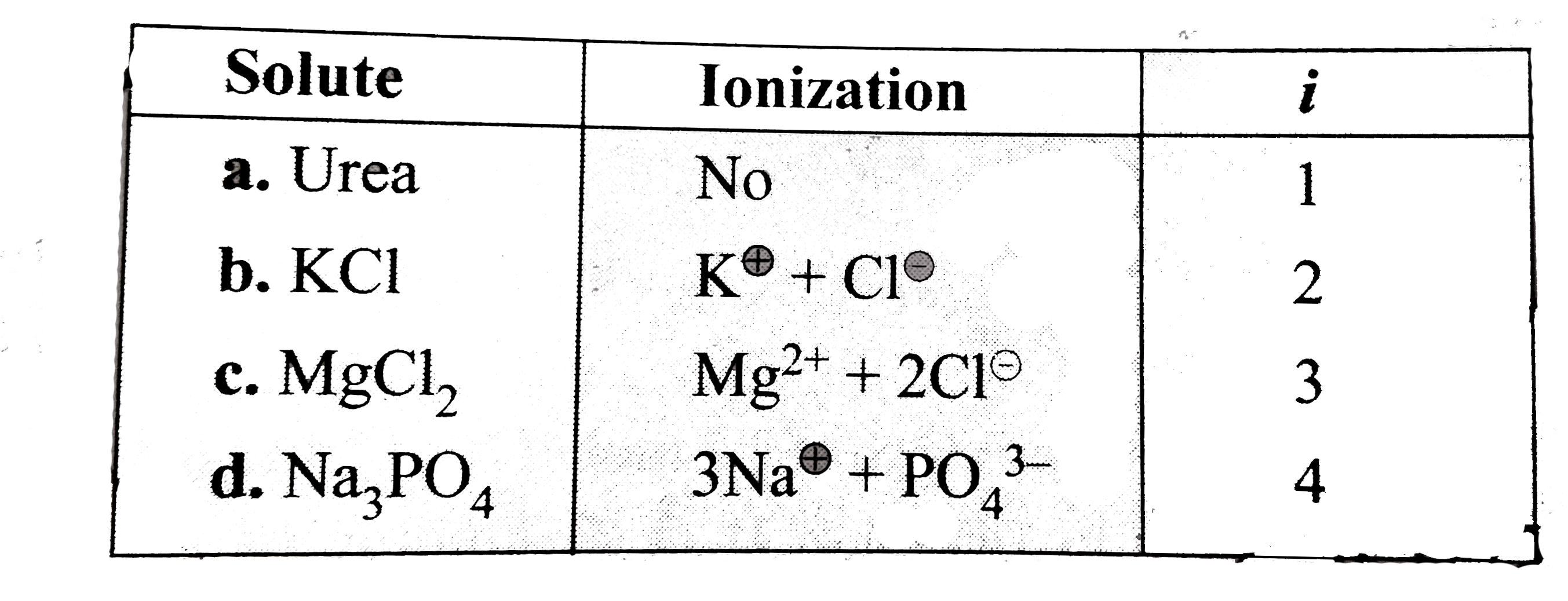Follwing are equimolal aqueous solution:
a.1murea , b.1mKCl , c.1mMgCl2 , d.1mNa3PO4
Arrange them in increaseing
i. Boiling point , ii.Freezing point , iii. Osmotic pressure , iv.Vapour pressure
While analysing the colligative properties, if the density of the solution is not given, take the molarity of the solution same as molality and vice-versa.
In such type of questions, always assume 100% dissociation for the ionic solutes until and unless specified

i. Boiling point of solution
Tb=Tb(∘)+(ΔTb)
ΔTb=i(Kbm)
Thus, greater the value of i, greater the value of ΔTb , and boiling point of solution.
a<b<c<d
ii. Freezing point of solution
Tf=Tf(∘)−(ΔTf)
ΔTf=i(Kfm)
Thus, greater the value of i, greater the value of ΔTf , but smaller the value of freezing point.
d<c<b<a
iii. Osmotic pressure (π)
(π)=iCRT
Thus, greater the value of i, larger the value of osmotic pressure.
a<b<c<d
iv. Vapour pressure of solution
ΔPP∘A=iχB
or ΔPP∘A=inBnA+nB≈nBnA
Thus, greater the value of i,greater the value of ΔP. Hence , smaller the value of vapour pressure of solution.
d<c<b<a
Topper's Solved these Questions
- BOOK - CENGAGE CHEMISTRYCHAPTER - SOLUTIONSEXERCISE - Solved Examples40videos
SOLUTIONS
- BOOK - CENGAGE CHEMISTRYCHAPTER - SOLUTIONSEXERCISE - Exercises (Linked Comprehension)58videos
SOLUTIONS
- BOOK - CENGAGE CHEMISTRYCHAPTER - SOLID STATEEXERCISE - Ex 1.2 (Objective)9videos
SOLID STATE
- BOOK - CENGAGE CHEMISTRYCHAPTER - SURFACE CHEMISTRYEXERCISE - Archives Subjective2videos
SURFACE CHEMISTRY
Similar Questions
Following are equimolal (=equimolar) aqueous solutions.
(A) 1 m glucose (B) 1 m NaCI © 1 m BaCI2 (D) 1 m Na3PO4 € 1 m benzoic acid
Assume 100% ionisation in B, C, D and 100% dimer formation in E, arrange the following in increasing (i)boiling point (ii) freezing point (iii) osmotic pressureView SolutionFollowing are equimolal (=f equimolar) aqueous solutions
(A) 1mglucose
(B) 1mNaCl (C) 1mBaCl2
(D) 1mNa3PO4 (E) 1m benzoic acid.
assume 100% ionisation in B,C,D and 100% dimer formation in E arrange them in increasing (1) boiling point, (2) freezing point, (3) osmotic pressure, (4) vapour pressure.\View Solution
Knowledge Check
- Question 1 - Select One or More
The relative lowering of vapour pressure of an aqueous solution of urea is 0.018. If Kb for H2O is 0.54∘m−1, the elevation in boiling point will be
A0.54∘CB0.18∘CC0.54 KD0.18 K - Question 2 - Select One
Addition of non-volatile solute to a solvent always inceases the colligative properties such as osmotic pressure, ΔP,ΔTb and ΔTf. All these colligative properties are direactly propertional to molality if solutions are dilute. The increase in colligative properties on addition of non-volatile solute is due to incease in number of solute particles.
For different aqueous solutions of 0.1NNaCl,0.1N urea, 0.1NNa2SO4 and 0.1NNa3PO4 solution at 27∘C, the correct statement are :
(P) The order of osmotic pressure is, NaCl>Na2SO4>Na3PO4> urea
(Q) π=ΔTbKb×ST for urea solution
(R) Addition of salt on ice increases its melting point
(S) Addition of salt on ice brings in melting earlierAQ, R, SBP, Q, SCP, Q, RDR, S - Question 3 - Select One or More
Consider the following solutions:
I.1 M sucrose , II. 1 M KCl
III.1 M benzoic acid in benzene
IV.1M(NH3)3PO4
Which of the following is/are true?AAll solutions are isotonic.BIII is hypotonic of I,II, and IV.CI,II, and III are hypertonic of IV.DIV is hypertonic of I,II, and III.
Out of 1M urea solution and 1M KCI solution, which has higher freezing point ?
View SolutionArrange the following solutions as directed:
Increasing order of boiling points.
0.001mNaCl , 0.001 m urea
0.001mMgCl2 , 0.001mCH3COOH
Increasing order freezing points.
0.1 M ethanol ,0.1MBa3(PO4_(2)
0.1MNa2SO4
Increasing order of osmotic pressure.
0.1M glucose ,1% urea solution
0.1M common salt
Increasing order of Van't Hoff factor. ltBrgt NaNO3 , BaCl2
K3[Fe(CN)6 ,C6H12O6
CH3COOHView SolutionThe elevation in boiling points of 0.1m aqueous solutions of NaCI,CuSO4 and Na2SO4 are in the ratio
View SolutionDepression in freezing point for 1 M urea, 1 M NaCl and 1 M CaCl2 are in the ratio of
View SolutionIf osmotic pressure of 1M urea is π , what will be the osmotic pressure for 0.1 M NaCl?
View Solution

